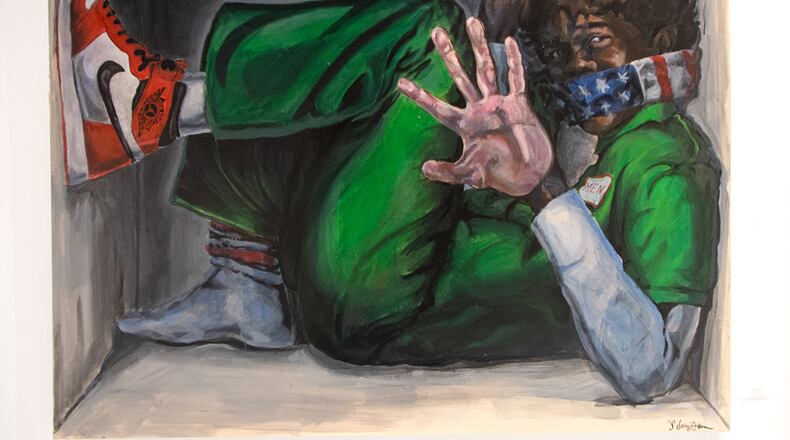This story was originally published by ArtsATL.
“I’m a 6-foot-7, dark-skinned, Black male. I’m, quote-unquote, imposing,” artist Ralph “rEN” Dillard said, describing his experience as a Black man and how this shaped the exhibition he co-curated with friend and fellow artist Brian Hebert. “I’ve experienced people locking doors around me, clinching their purses and their pearls whenever I walk into a room. I’d like to think that I’m a gentle giant. Society doesn’t speak to that.”
“Hold the Line, Volume II: Celebrating Black Masculinity” — a group exhibition at ArtsXchange’s Jack Sinclair Gallery in East Point running through Oct. 26 — originated from conversations he and Hebert had been having around their shared experiences and their desire to amplify what they were grappling with through artistic expression.
“My work,” Dillard said, “is centered around celebrating the Black experience — the melanated experience.”
Credit: Photo courtesy of Kevin Cole / T.W, Meyer
Credit: Photo courtesy of Kevin Cole / T.W, Meyer
The debates surrounding Black men have often been waged on the battleground of race, culture and politics. “Hold the Line,” with its reference to militarism and war, is an apt title.
The aesthetic intervention imagined by Dillard and Hebert isn’t narrowly or simplistically ideological. The diversity of Black male artists in the exhibition ensures a dynamic dialogue across artistic approaches between the works. Dillard and Hebert may understand the exhibition itself as a kind of statement, but, being in the space, “Hold the Line” feels more like a conversation. Each of the 35 artists in his own way presents a way of imagining Black masculinity beyond stereotype, myth and racist fantasy.
The artistic forebearer of the show, “Black Male: Representations of Masculinity in Contemporary American Art, which opened in 1994 at the Whitney Museum of American Art, lurks in the shadows of the current exhibition. Whereas “Black Male” inspired debates around the limits of representation and inclusion of non-Black artists, “Hold the Line” locks arms against any intrusion of whiteness by featuring only Black male artists.
The curator is as much a grand military tactician as a cultural worker. “Hold the Line” doesn’t critique how white people see Black men; it seeks to explore how Black men see themselves. For example, the late Robert Mapplethorpe, a white photographer whose work was included in “Black Male,” would be unlikely to find a place for his work in “Hold the Line.”
Credit: Photo courtesy of Tafawa Arthur Hicks
Credit: Photo courtesy of Tafawa Arthur Hicks
Black people are still written about, represented and exploited on social media, news coverage and popular culture through a racist lens. And this is certainly the case for Black men. For the exhibition to center on Black male artists telling their own stories through their art is refreshing if not subversive.
The weight of history looms over the exhibit, but it’s never crushing. There is grief, but there is also joy. Through the exhibition we see Black men and boys in various expressions: as boxed in by society yet resilient in Darius Parker’s “The View”; as a graceful dancer in Arthur Tafawa Hicks’ “John Parkers, Dancer”; and as utterly deconstructed into a silhouette and a series of wires in Dante Yarbrough’s “Structural Complexity.”
Though the dominant narrative of Black men in American culture may be of violence and sex, this exhibition seeks to combat that not just through critique but through creating a revolutionary visual counternarrative. In this sense, they change the terrain of the debate so it’s on their terms.
The art in the show is layered, each piece coded and embedded with cultural references and personal memory. Each artist invites you to linger, to interact with his work, which at times feels personal and intimate. For Dillard, the artist’s experience in the exhibition is one where he hopes “you can take off your armor and be vulnerable around other Black men who have experienced the same things you’ve experienced.”
Credit: Courtesy of Ralph “rEN” Dillard
Credit: Courtesy of Ralph “rEN” Dillard
Flight emerges as a recurring theme in the exhibition.
Tony Smart’s sublime “Super Friends” is a mixed-media work depicting three standing boys wearing capes. Each are masked: one adorned in green, another red and another yellow. Aaron Henderson’s “Flee — Flight to Afrolantica” is an oil painting of a Black man’s feet rising as if in flight above a pair of boots set out on a green, a reference to Black folklore and freedom. And Dillard’s stunningly cinematic mixed-media piece “Icarus” features a winged Black boy surrounded by birds and skyscrapers who takes aim with his bow at a helicopter flying above him.
Tenderness and vulnerability as strengths also recur, effectively creating a visual language to reimagine Black masculinity.
Smart’s poetic “Man Class 101: Father Teaching Son,” is a black-and-white image of a father teaching his son how to tie his tie in the mirror. Najee Dorsey’s “Two Generations” is a photomontage of a Black man teaching his son to play the trumpet. And Arturo Lindsay’s mixed-media piece, “Dear Lord … Why … (did) Qa’id Have to Die,” features an angelic figure set against a luminous blue glow.
Each artist represents Black masculinity in his own terms, in his own way. Hebert’s “A Dope Piece of Fruit #6, Leon’s Dream” is, on the surface, irreverent — a watermelon with headphones — but also rejects the assumption that Black artists must create overt social commentary and realism through their work.
Credit: Photo courtey of Najee Dorsey
Credit: Photo courtey of Najee Dorsey
There is whimsy in the show but also realism. A decade of seeing brutal images of Black bodies killed by the police on social media does not escape the art space. The impact of the criminal justice system and collective defiance is engaged in Jim Alexander’s “Each Generation,” where we view images from Black Lives Matter actions. There are various banners and protest signs, including one that says “Stop Shooting Us” and another that says “400 Years of Oppression. We Demand Our Rights.”
Credit: Photo by Tafawa Arthur Hicks
Credit: Photo by Tafawa Arthur Hicks
Hebert’s multilayered work, inspired by both his love of hip-hop culture and keen observation that our music and our agriculture nourish us, is an example of what becomes possible when Black artists have the freedom to create for themselves. That is ultimately the point of the exhibition.
Dillard also has an exhibition opening in November at Mason Fine Art called “Letters to Deja,” which he describes as a visual letter to his daughter. As for his aspirations for the show, Dillard hopes it will travel. The possibility of this show appearing in galleries and community spaces, particularly in the South, has immense potential for inspiring dialogue and building bridges.
“We made a concerted effort to kind of cherry-pick from different art ecosystems and bring them all together in this one show — whether that was differences in sexuality, whether that was differences in styles, whether that was differences in location, age,” Dillard said. “We wanted to sprinkle a little bit of everything and essentially hold the line.”
ART PREVIEW
“Hold the Line, Volume II: Celebrating Black Masculinity”
At ArtsXchange’s Jack Sinclair Gallery through Oct. 26. 10 a.m.-6 p.m. Tuesdays-Saturdays. Free. 2148 Newnan St, East Point. 404-624-4211, artsxchange.org
::
Charles Stephens is an Atlanta-based writer. His work has appeared in publications such as Atlanta magazine, Creative Loafing, The Atlanta Journal-Constitution, Georgia Voice, the Advocate and Them.
Credit: ArtsATL
Credit: ArtsATL
MEET OUR PARTNER
ArtsATL (artsatl.org) is a nonprofit organization that plays a critical role in educating and informing audiences about metro Atlanta’s arts and culture. ArtsATL, founded in 2009, helps build a sustainable arts community contributing to the economic and cultural health of the city.
If you have any questions about this partnership or others, please contact Senior Manager of Partnerships Nicole Williams at nicole.williams@ajc.com.
About the Author
Keep Reading
The Latest
Featured






